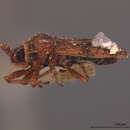mk
имиња во трошки


Leptoypha minor also known as the Arizona ash lace bug is a species of lace bugs in the family Tingidae.[1][2] It is found in North America and is very common in California.[2][3] It is considered a pest that causes twig and foliage damage to Oregon ash trees in addition to other types of ashes. Adult lace bugs can be found hibernating on ash trees during the winter, and during the spring, nymphs begin to emerge. Breeding continues throughout spring until October. [3] L. minor differs from other common lace bugs in that they are generally a light-reddish brown and can grow up to 2 mm (excluding antennae). They are compact in body form but lack the lacy lateral lobes of other lace bug species.[4]
Eggs
Eggs are laid partially embedded in the leaf tissue at the sides or veins on the under surfaces of leaves. A prominent, oval, disk-like cap projects upward and is prominent. The average length of the egg stage late in August in cellophane cages was 14 days. The five nymphal instars required 5, 7, 3, 3, and 6 days, making a total period of 38 days from egg to adult. Eggs usually begin appearing late in April with generations continually maturing every month until October. It seems likely that the species undergoes 4 or possibly 5 generations a year in the vicinity of Davis, Calif. The population thus builds up to injurious numbers by late summer.[3]
Nymphs
Nymphs are flattened, spiny, and live in colonies on the under sides of leaves. After passing through five nymphal stages, they leave their cast skins on the leaf surface. This causes whitening of the leaves and a black spotting underneath due to fecal deposits.
Adults overwinter in leaf litter until the next mating season.
{{cite web}}: CS1 maint: url-status (link) {{cite web}}: CS1 maint: url-status (link) Leptoypha minor also known as the Arizona ash lace bug is a species of lace bugs in the family Tingidae. It is found in North America and is very common in California. It is considered a pest that causes twig and foliage damage to Oregon ash trees in addition to other types of ashes. Adult lace bugs can be found hibernating on ash trees during the winter, and during the spring, nymphs begin to emerge. Breeding continues throughout spring until October. L. minor differs from other common lace bugs in that they are generally a light-reddish brown and can grow up to 2 mm (excluding antennae). They are compact in body form but lack the lacy lateral lobes of other lace bug species.
Leptoypha minor es una especie de hemíptero heteróptero de la familia Tingidae; es una plaga forestal, de hábito chupador/defoliador que ataca al plátano de sombra (Platanus).
México (Coahulila, Nuevo León, Tamaulipas).
Leptoypha minor es de color café sin mostrar lóbulos ornamentados como en Corythucha.
Existen de 3-5 generaciones al año. El invierno lo pasan generalmente como adultos. La oviposición se realiza al principio de la estación del crecimiento del árbol, a lo largo de los márgenes de las venas, por el envés de la hoja. Los huevecillos son insertados son parcialmente insertado en el envés de la hoja. Las ninfas son gregarias durante los primeros estadios y posteriormente se dispersan en el follaje de la rama infestada.
Las hojas se despigmentan, tomando una coloración gris plomizo, terminando por secarse y caer. En el envés, se observan pequeñas gotas de color negro parecidas a quemaduras debidas a la presencia de la melaza que segregan y al desarrollo secundario sobre ella de hongos conocidos como “fumaginas”. La gran cantidad de plátanos de sombra utilizados en jardinería en nuestras ciudades, así como las citas de esta plaga en otros géneros vegetales (Broussonetia, Carya, Fraxinus, Tila) de utilización también ornamental, obliga a considerar la expansión de este insecto como un grave problema para parques y jardines.
Hacia el mes de junio, realizar tratamientos mediante inyecciones al tronco con acefato. También se pueden realizar tratamientos contra las formas juveniles de Corythucha ciliata pulverizando la copa con piretroides naturales.
Leptoypha minor es una especie de hemíptero heteróptero de la familia Tingidae; es una plaga forestal, de hábito chupador/defoliador que ataca al plátano de sombra (Platanus).